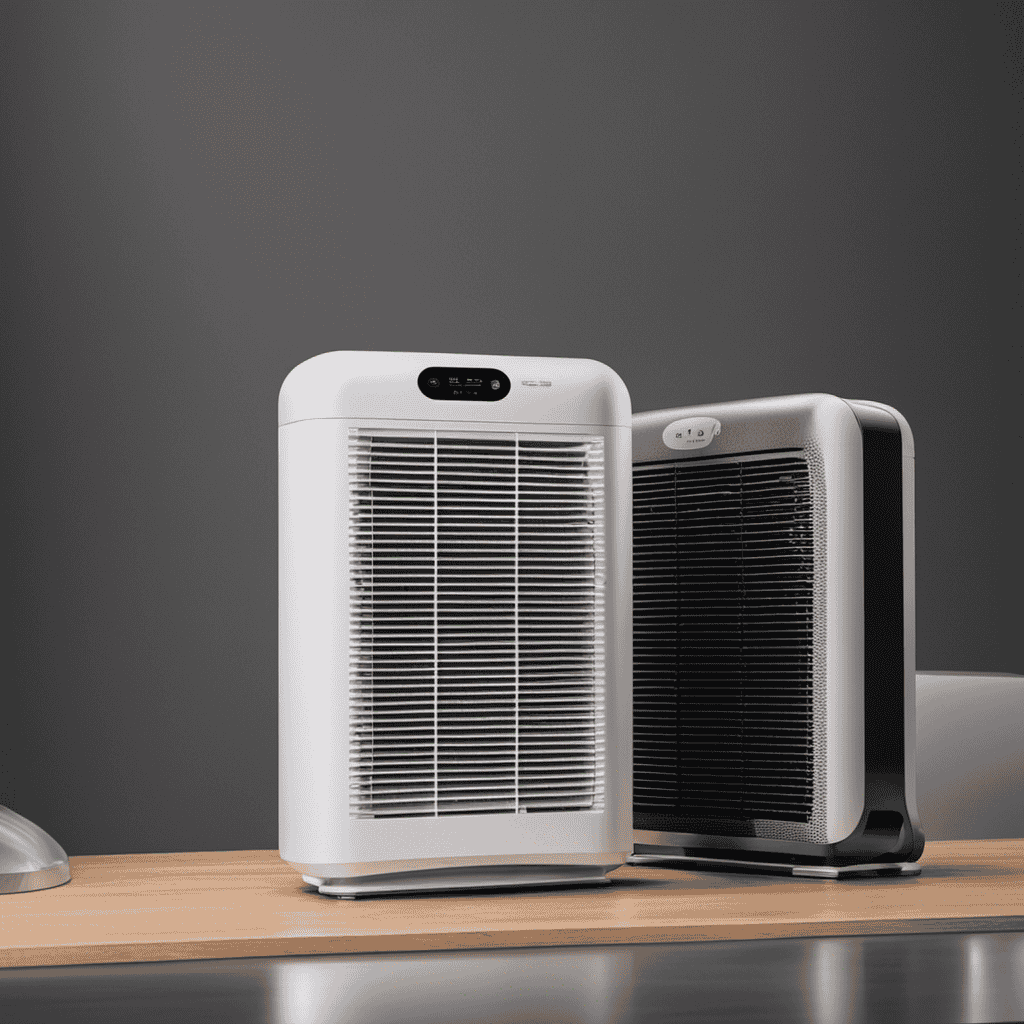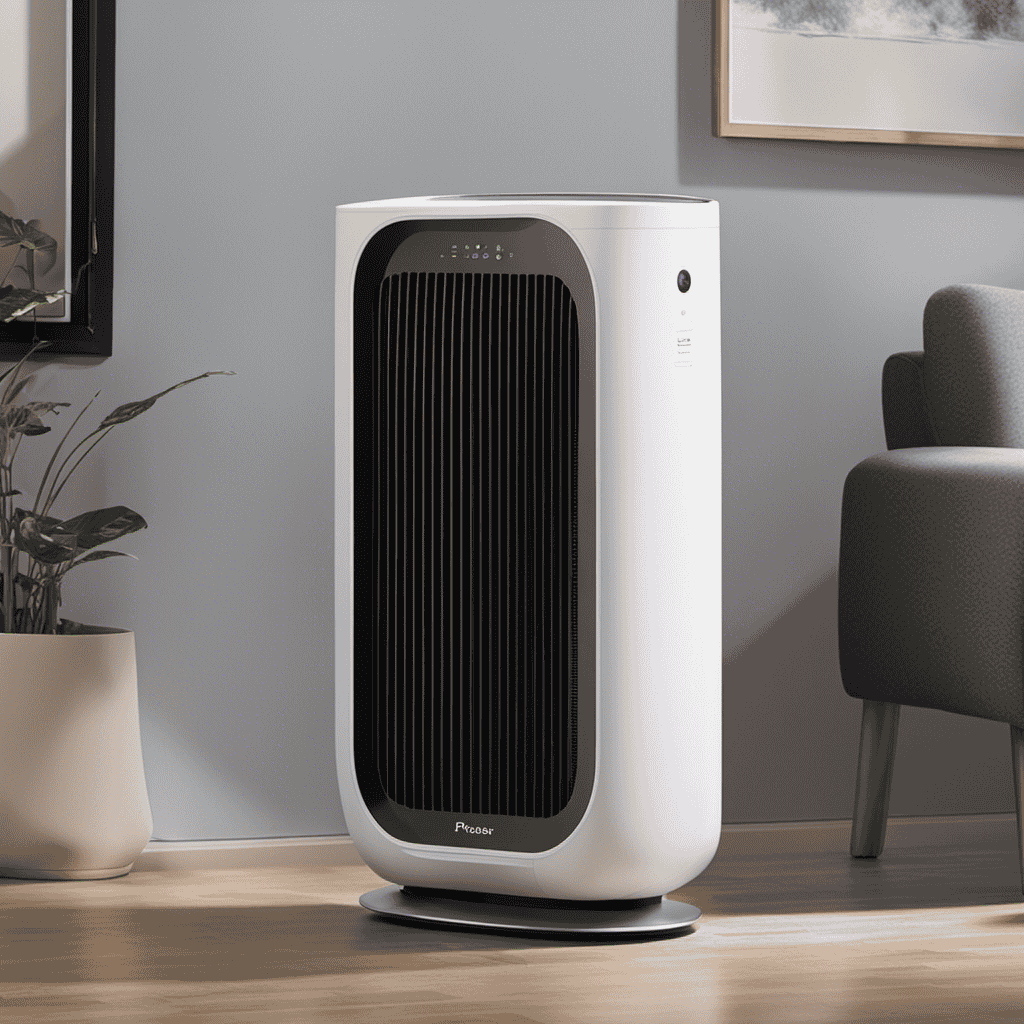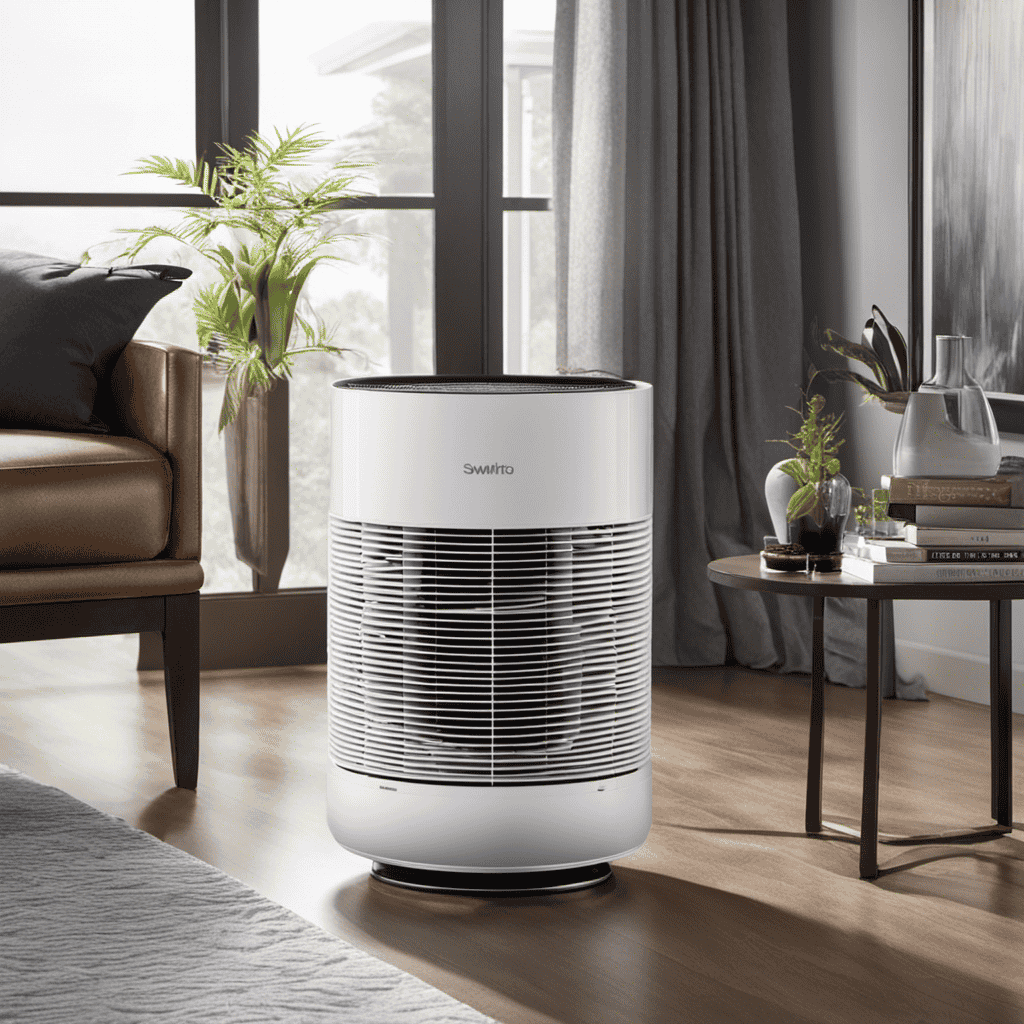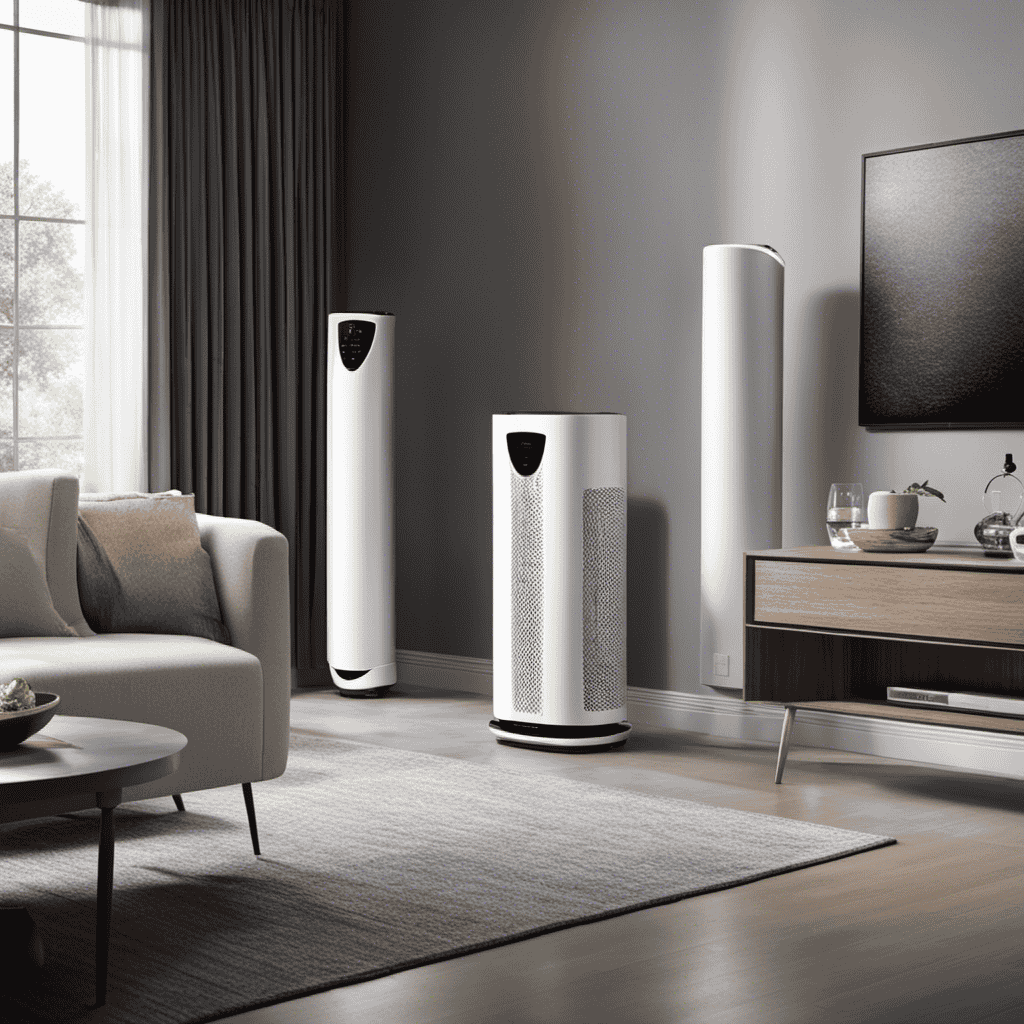As a fan of air quality, I understand the significance of keeping a air purifier filter clean and efficient.
Juxtaposing the need for clean air with the reality of dirty filters, it becomes clear that regular filter changes are essential.
In this article, I will guide you through the factors that affect filter lifespan and reveal the recommended frequency for filter changes.
By following these evidence-based tips, you can ensure that your air purifier is always working at its best to improve the quality of the air you breathe.
Key Takeaways
- Proper filter maintenance, including regular cleaning and replacement, is crucial in increasing filter lifespan.
- The recommended filter change frequency is usually every 3 to 6 months, depending on factors such as air quality and usage.
- HEPA filters are recommended for high efficiency and longer lifespan.
- Regularly replacing the filter maintains optimal performance, improves air quality, and prevents damage to the air purifier’s motor.
Factors That Affect Filter Lifespan
There are several factors that can affect how long an air purifier filter lasts. Proper filter maintenance is crucial in increasing filter lifespan. Regularly cleaning and replacing the filter is essential to ensure optimal performance and longevity.
Dust, pet dander, pollen, and other airborne particles accumulate on the filter over time, reducing its effectiveness. If the filter becomes clogged, it can negatively impact the air purifier’s airflow and filtration capabilities.
The frequency at which the filter needs to be changed depends on various factors, such as the air quality in your environment and the type of air purifier you have. It is recommended to follow the manufacturer’s guidelines and check the filter regularly.
Recommended Filter Change Frequency
When it comes to maintaining optimal air quality, one key factor is ensuring the proper replacement of air purifier filters.
Understanding the factors that affect filter lifespan is crucial in determining how often these replacements should occur.
Regularly changing filters is of utmost importance as it ensures maximum efficiency in removing pollutants from the air, promoting a healthier living environment.
Optimal Filter Replacement
The optimal time to change an air purifier filter is usually every 3 to 6 months. Regular filter replacement ensures the efficiency and effectiveness of your air purifier. Here are some factors affecting the efficiency and cost-effective options for filter replacement:
- Filter material: Different materials have varying lifespans and filtration capabilities. Consider HEPA filters for high efficiency and longer lifespan.
- Air quality: If you live in an area with high pollution or allergens, you may need to change the filter more frequently.
- Usage: Heavy usage, such as running the air purifier constantly or in a large room, may require more frequent filter changes.
- Pets: If you have pets, their dander and hair can clog the filter faster, necessitating more frequent replacements.
- Filter quality: Investing in filters from reputable brands can provide better performance and longer lifespan, making them more cost-effective in the long run.
Considering these factors will help you make informed decisions about when to replace your air purifier filter.
Now, let’s explore the factors affecting filter lifespan.
Factors Affecting Filter Lifespan
Investing in filters from reputable brands can provide better performance and a longer lifespan, making them more cost-effective in the long run.
However, proper maintenance is key to maximizing the lifespan of your air purifier filter. It is recommended to regularly clean your filters to remove accumulated dust and debris. This can be done by gently vacuuming or washing the filter, following the manufacturer’s instructions.
Additionally, some air purifiers come with filter replacement indicators, which monitor the filter’s condition and alert you when it needs to be replaced. These indicators use various methods such as sensor technology or timer-based alerts.
Importance of Regular Changes?
Regularly replacing your air purifier filter is essential for maintaining optimal performance and maximizing its lifespan. Neglecting to change the filter can result in reduced effectiveness and potentially cause health issues.
Here are some key reasons why regular filter changes are beneficial:
-
Improved Air Quality: Air purifier filters trap and remove harmful pollutants, allergens, and irritants from the air, ensuring cleaner and healthier indoor air quality.
-
Enhanced Efficiency: A clean filter allows the air purifier to operate more efficiently, effectively capturing and eliminating airborne contaminants.
-
Prolonged Lifespan: Regular filter changes prevent clogging and damage to the air purifier’s motor, extending its lifespan and saving you money in the long run.
-
Allergy Relief: By removing allergens like pollen, dust mites, and pet dander, regularly changing the filter can provide relief for allergy sufferers.
-
Odor Reduction: Certain air purifier filters, like activated carbon filters, can help eliminate unpleasant odors from cooking, pets, or smoke.
While there may be some costs associated with replacing filters, the benefits of regular filter changes far outweigh the cons, ensuring a healthier and cleaner indoor environment.
Signs That Your Air Purifier Filter Needs to Be Replaced
If you notice a decrease in air quality or an increase in allergy symptoms, it’s likely time to replace your air purifier filter. Regularly changing your air purifier filter is crucial for maintaining clean and healthy indoor air.
The recommended filter change frequency for most air purifiers is every 3 to 6 months, depending on the manufacturer’s guidelines and usage. Over time, the filter accumulates dirt, dust, pollen, pet dander, and other airborne particles, reducing its efficiency. This can lead to decreased air quality and increased allergy symptoms.
Regular filter changes ensure that your air purifier continues to effectively remove pollutants from the air, providing you with clean and fresh indoor air. Don’t neglect the importance of regular filter changes, as they play a vital role in maintaining the performance and effectiveness of your air purifier.
How to Extend the Lifespan of Your Air Purifier Filter
One way to prolong the life of your air purifier filter is by properly cleaning and maintaining it. Regular maintenance and cleaning can help extend the filter efficiency and maximize its performance. Here are some tips to help you get the most out of your air purifier filter:
- Vacuum the filter regularly to remove dust and debris.
- Wash the filter with mild soap and water, following the manufacturer’s instructions.
- Allow the filter to dry completely before reinstalling it.
- Avoid using harsh chemicals or solvents on the filter, as they can damage the material.
- Replace the filter according to the manufacturer’s recommendations to ensure optimal performance.
Different Types of Air Purifier Filters and Their Lifespan
To get the most out of your air purifier, it’s important to understand the different types of filters and how long they typically last. Choosing the right filter type is crucial for optimal filter performance.
There are three common types of air purifier filters: HEPA filters, activated carbon filters, and pre-filters. HEPA filters are highly effective at capturing small particles like dust, pollen, and pet dander. They usually last around 6 to 12 months, depending on the air quality and usage.
Activated carbon filters are great for removing odors and chemicals. They typically last for 3 to 6 months. Pre-filters, on the other hand, help prolong the lifespan of the main filter by capturing larger particles. They should be replaced every 2 to 3 months.
Understanding the lifespan of each filter type will help you maintain optimal filter performance and ensure clean and fresh air in your home.
Common Mistakes to Avoid When Changing Air Purifier Filters
When it comes to changing air purifier filters, there are a few common mistakes that should be avoided.
Proper filter replacement is key to ensuring the effectiveness of your air purifier.
Avoiding filter contamination is also crucial in maintaining the quality of the air in your space.
Lastly, understanding the frequency of filter changes will help you keep your air purifier running efficiently.
Proper Filter Replacement
Replacing the air purifier filter regularly ensures cleaner and healthier air quality in your home. Proper air purifier maintenance is crucial to maximizing filter efficiency. Here are some key tips to help you maintain your air purifier effectively:
- Follow the manufacturer’s recommendations for filter replacement intervals.
- Monitor the filter’s condition regularly and change it as needed.
- Clean or replace pre-filters regularly to prevent clogging.
- Vacuum or wipe down the air purifier’s exterior to remove dust and debris.
- Consider using a filter replacement reminder or scheduling system to ensure timely replacements.
By following these maintenance practices, you can ensure that your air purifier operates efficiently, capturing a higher percentage of pollutants and allergens in the air. This will contribute to a healthier indoor environment for you and your family.
To avoid filter contamination and maintain optimal air purifier performance, it’s important to understand common mistakes to avoid when changing air purifier filters.
Avoiding Filter Contamination
As I mentioned before, proper filter replacement is crucial for maintaining the efficiency of an air purifier. However, it is equally important to prevent filter contamination in the first place. Regular maintenance plays a vital role in preventing filter clogging and ensuring optimal performance. By following a few simple steps, you can significantly extend the lifespan of your air purifier filter.
One effective method of preventing filter clogging is to regularly clean the pre-filter, which captures larger particles such as dust and pet hair. This can be done by vacuuming or rinsing the pre-filter according to the manufacturer’s instructions.
Another important aspect of maintenance is keeping the surrounding area clean. Dusting and vacuuming regularly will help minimize the amount of debris that can potentially clog the filter.
Finally, it is crucial to follow the manufacturer’s recommendations regarding the replacement frequency of your air purifier filter. This ensures that it operates efficiently and effectively in removing pollutants from the air.
By taking these preventive measures and performing regular maintenance, you can avoid filter clogging and maximize the lifespan of your air purifier filter.
Now, let’s delve into the next section where we will discuss the frequency of filter changes and the factors that influence it.
Frequency of Filter Changes
Regular maintenance is key in determining how frequently you should change your air purifier filter. Several factors can affect the effectiveness of your air purifier filter and indicate when it’s time for a replacement.
Here are some signs of a clogged filter and factors to consider:
-
Reduced airflow: If you notice a decrease in the airflow from your air purifier, it could indicate a clogged filter. A clogged filter restricts the movement of air, resulting in reduced efficiency.
-
Excessive dust buildup: A dirty filter accumulates dust and debris over time. If you observe a thick layer of dust on the filter, it’s a clear indication that it needs to be replaced.
-
Odor or allergen recurrence: An ineffective filter may fail to eliminate odors or allergens from your indoor air. If you notice a return of unpleasant smells or allergy symptoms, it’s time for a filter change.
-
Manufacturer’s recommendations: Check the manufacturer’s instructions for your specific air purifier model. They usually provide guidelines on how often the filter should be changed.
-
Usage and environment: Factors like the level of air pollution in your area and the frequency of air purifier usage can affect filter lifespan. Consider these factors when determining how often to change your filter.
Proper Maintenance and Cleaning for Air Purifier Filters
To keep your air purifier running efficiently, it’s important to regularly clean and maintain the filters. Neglecting the filters can result in reduced performance and poor air quality. Follow these tips for cleaning air purifier filters to ensure optimal functioning:
| Tip | Description | Frequency |
|---|---|---|
| Vacuuming | Use a soft brush attachment to remove dust and debris from the filter surface. | Every 2 weeks |
| Washing | If the filter is washable, gently rinse it with water and let it dry completely before reinstalling. | Every 3 months |
| Replacement | Non-washable filters should be replaced as recommended by the manufacturer. | Every 6-12 months |
Regular maintenance is vital for the longevity and effectiveness of your air purifier. By following these cleansing techniques, you can prolong the life of your filters and ensure clean and healthy air in your home. Don’t forget to consult your purifier’s manual for specific maintenance instructions.
What are the recommended replacement intervals for air purifier filters?
The air purifier filter change frequency depends on various factors like the type of filter, air quality, and usage. Generally, HEPA filters should be replaced every 6-12 months, while carbon filters may need replacement every 3-6 months. It’s essential to follow the manufacturer’s recommendations for optimal performance.
Frequently Asked Questions
What Are the Benefits of Regularly Changing Your Air Purifier Filter?
Regularly changing your air purifier filter is crucial for maintaining clean air and ensuring the best indoor air quality. It prevents the buildup of pollutants, allergens, and bacteria, ultimately benefiting your health and well-being.
Can Using a Higher Quality Air Purifier Filter Extend Its Lifespan?
Using a higher quality air purifier filter can increase its efficiency and extend its lifespan. Regular maintenance, such as changing the filter as recommended, can have a significant impact on its overall performance and longevity.
Are There Any DIY Methods to Clean and Prolong the Lifespan of an Air Purifier Filter?
DIY cleaning methods and maintenance tips can help prolong the lifespan of an air purifier filter. Regularly vacuuming the filter and washing it with water can remove dirt and debris, ensuring optimal performance.
How Do I Know if My Air Purifier Filter Is Not Working Properly Even if It Hasn’t Reached Its Recommended Change Frequency?
If my air purifier filter isn’t working properly before it’s due for a change, there are a few signs to watch for. Reduced airflow, strange odors, or increased dust are indications of a faulty filter. Troubleshoot by cleaning or replacing the filter.
Are There Any Specific Factors or Pollutants That Can Significantly Shorten the Lifespan of an Air Purifier Filter?
Factors such as high levels of pollutants like smoke, pet dander, and pollen can significantly shorten the lifespan of an air purifier filter. These specific pollutants put extra strain on the filter, requiring more frequent replacements.
Conclusion
In conclusion, maintaining a regular schedule for changing your air purifier filter is crucial for ensuring clean and healthy air in your home. By following the recommended filter change frequency and keeping an eye out for signs of wear and tear, you can optimize the performance of your air purifier.
Remember to avoid common mistakes and properly clean and maintain your filter for extended lifespan. With these tips, you can breathe easier and enjoy the benefits of a well-functioning air purifier.
So why wait? Start improving your indoor air quality today.










